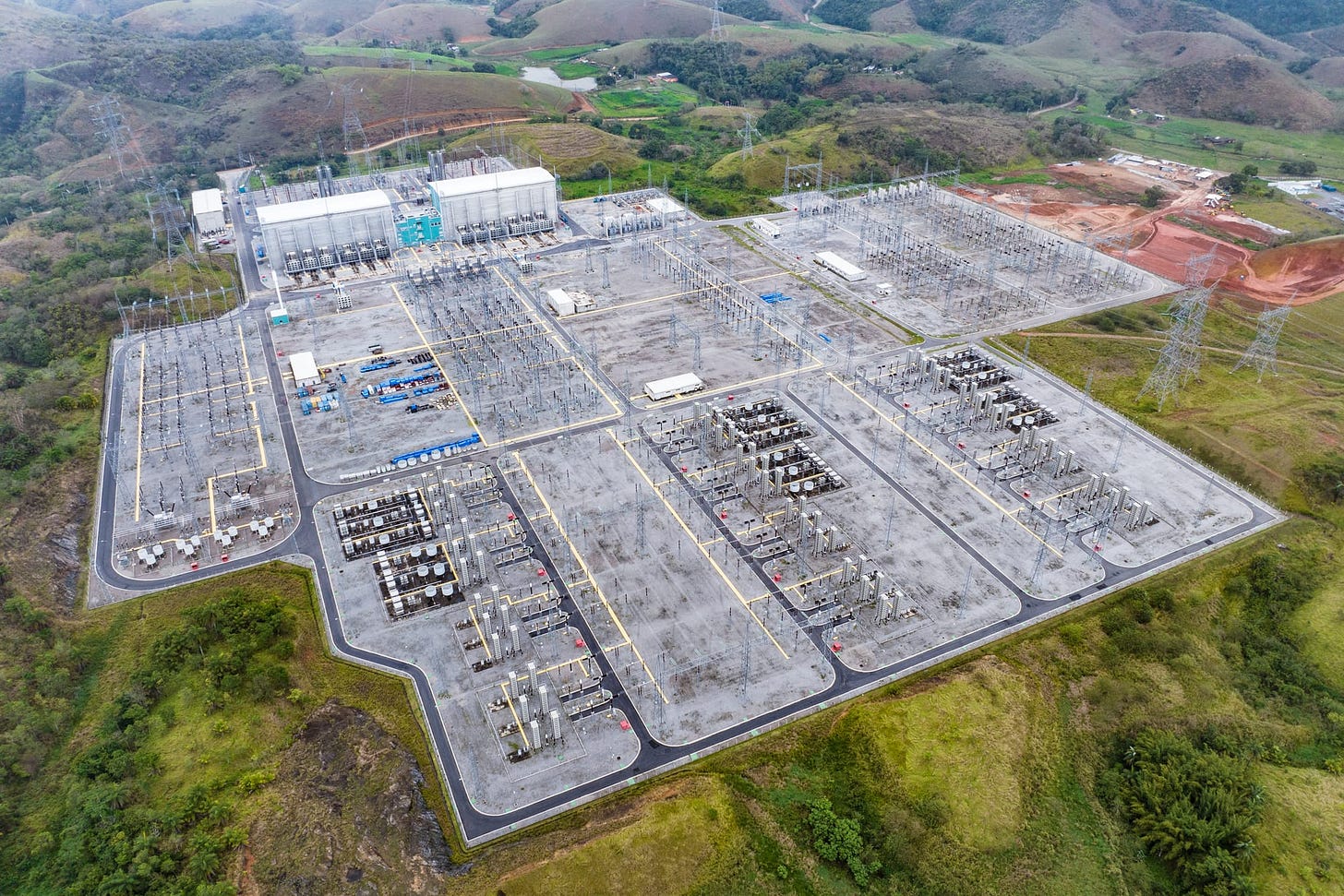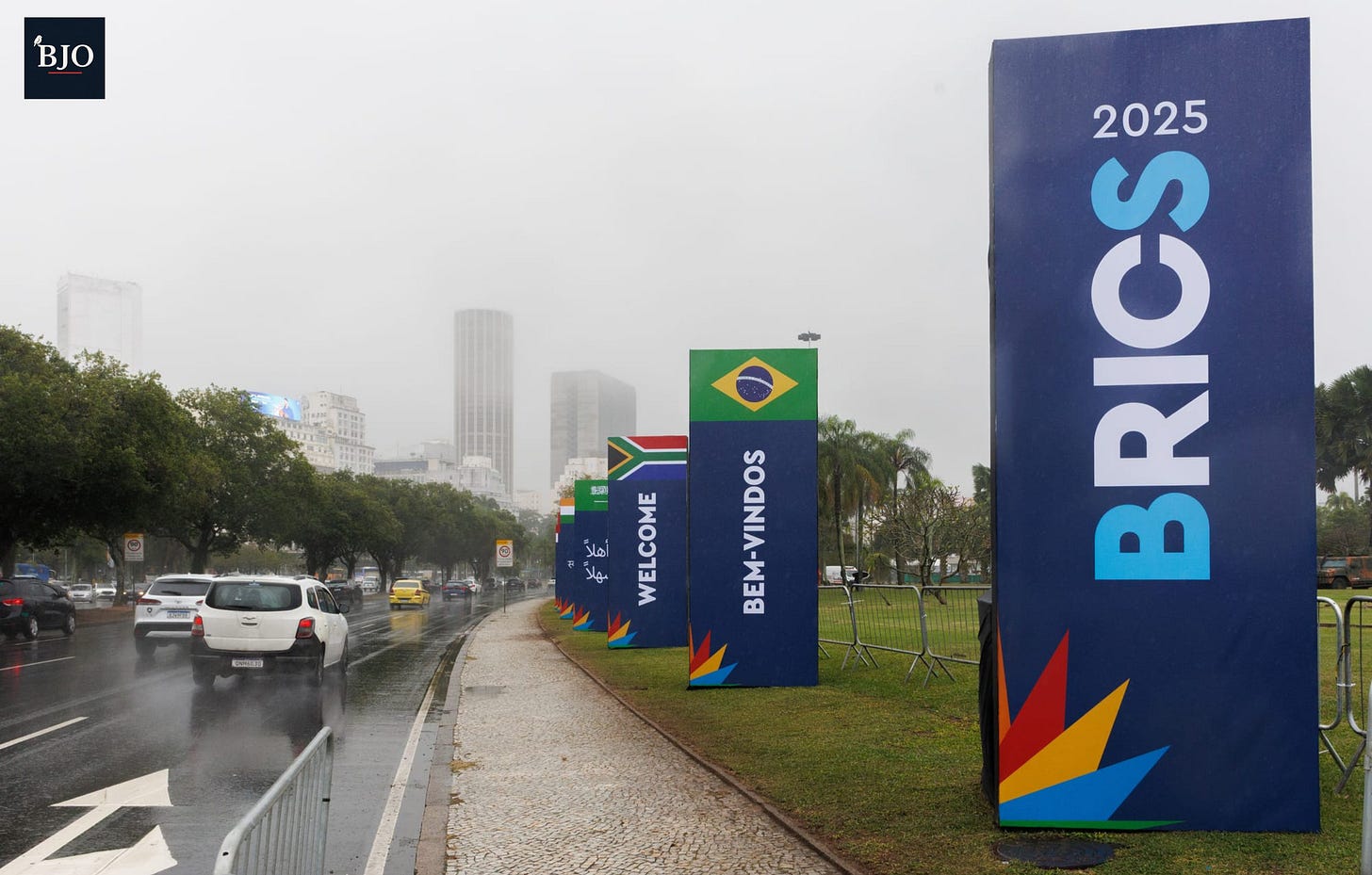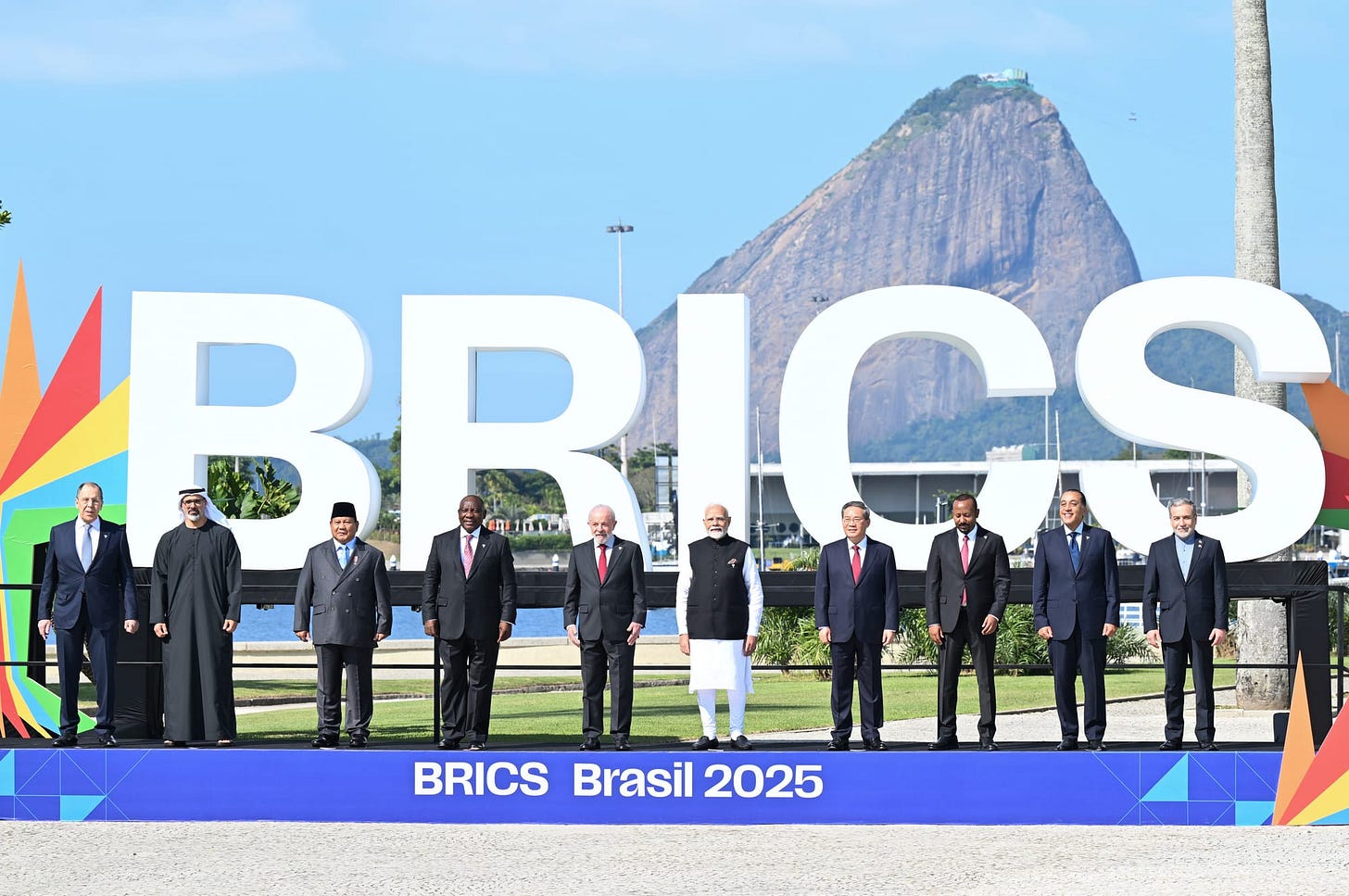BRICS And A New Order Behind It
It’s not Anti-Western, it’s Post-Western.
Editor’s Note: Trump is growing furious over BRICS, branding it as “anti-American.” But perhaps the real issue isn’t BRICS itself—it’s the current world order, led by a United States that, under Trump’s administration, seems to be running an auto-destruction program of its own. What’s wrong with the U.S.-led order? Why is its global appeal fading beyond repair? And what’s driving the rise of BRICS as an alternative? This article may offer you some answers.
On the morning of July 6, the 17th BRICS Summit officially opened in Rio de Janeiro, Brazil. This is not just an ordinary gathering of non-Western countries but a quiet yet unmistakable declaration: a brand-new global system is steadily taking shape.
Despite years of skepticism, ridicule, and containment attempts from the Western world, the BRICS mechanism continues to expand its institutional influence, global importance, and strategic cohesion. Today, BRICS boasts ten official member countries, an ever-expanding circle of partners, and more than fifty nations seeking membership. It has evolved beyond being merely a diplomatic forum; it now represents a significant force in the emerging multipolar world and serves as a structural response to the increasingly acute contradictions of Western-dominated globalization.
In nominal terms, BRICS nations collectively account for over 45% of global GDP and more than 50% based on purchasing power parity. The bloc represents more than half of the world's population. More critically, it controls a substantial share of global energy reserves, industrial capacity, and key mineral resources, positioning itself at the core of global stability through its real economy.
This influence goes beyond economics and carries systemic significance. In a world where the material foundations of prosperity—energy, infrastructure, and food systems—are under threat, BRICS offers an international cooperation model rooted in shared development, strategic autonomy, and infrastructural connectivity: sovereign independence paired with mutual interdependence.
Real Economy and Systemic Exchange Value
Unlike the financialized Western economies, BRICS economies are still anchored in what the author calls the logic of "systemic exchange value". This value refers to the capacity to create and circulate real use-value essential for societal reproduction and sustainable economic development. Within this framework, energy is not merely a commodity for speculative trading; it is the foundation of productive life itself—the energy basis upon which value is created, stored, and exchanged.
In this regard, BRICS holds decisive structural advantages. Russia, Iran, Brazil, the UAE, and Saudi Arabia are major energy producers. China leads in installed renewable energy capacity, grid innovation, and energy storage technologies. These endowments enable BRICS members to anchor value in material reproduction rather than relying on financial abstraction.
This stands in sharp contrast to the West—especially the United States—where value extraction has become decoupled from actual production. Beginning in the 1970s, financial market liberalization evolved into a hyper-financialized system, where profits are driven less by technological innovation or productivity and more by asset inflation, debt-leveraged speculation, and shareholder value enhancement.
The U.S. Financial Model: Global Distortion and Domestic Hollowing
Over the past four decades, the transformation of the U.S. economy has been profound and destructive. Monetary capital surged into financial assets rather than physical infrastructure. Corporations prioritized stock buybacks over fixed capital investments. Banks shifted from lending to productive enterprises to acting as speculative platforms.
The result is a polarized economy: financial wealth accumulates at the top, while stagnation and income instability plague the bottom. Domestically, this has led to widening inequality, shrinking industrial jobs, and decaying infrastructure. Most Americans have seen real wages stagnate, household debt soar, and now face declining life expectancy and unaffordable healthcare, housing, and education costs. Politically, this fuels social division, public disillusionment, and a rise in cultural warfare and nostalgia.
Globally, the consequences are equally corrosive. The U.S. dollar’s role as the world’s reserve currency allows the U.S. to export volatility through persistent trade deficits, shifting its internal imbalances outward. To access global markets, other nations must hold dollar reserves, binding their monetary policies to the U.S. Federal Reserve and exposing them to cyclical risks of capital flight, interest rate shocks, and dollar liquidity shortages.
The U.S. increasingly depends on capital inflows to sustain consumption while its real economy contracts. Meanwhile, it weaponizes international financial infrastructure—SWIFT, sanctions, dollar clearing—for geopolitical leverage. The more these tools are used coercively, the greater the incentive for the rest of the world to develop alternatives. Yesterday’s privilege has become today’s burden.
Europe’s Economic Disintegration: Energy, Competitiveness, and Strategic Drift

Western Europe faces a different but equally severe crisis. Its postwar development model—anchored in German industrial exports, French agricultural stability, and cheap energy imports (mainly from Russia)—has been shattered by geopolitical ruptures and policy confusion. Cutting off Russian energy supplies plunged Europe into structural energy insecurity. Natural gas prices surged, electricity costs soared, and industries relocated or shut down. Germany’s industrial backbone—steel, chemicals, automobiles—now struggles for survival.
Simultaneously, Europe’s green transition has stalled, undermined by over-reliance on intermittent renewables, premature nuclear and fossil fuel phase-outs, and underinvestment in storage and grid resilience. These factors have combined into a "perfect storm" that left its energy system dangerously fragile. A transformation effort has devolved into an energy trap.
Europe’s response—subsidies, tariffs, and rhetoric about "strategic autonomy"—amounts to passive protectionism. Geopolitically, Europe grows increasingly contradictory: championing multilateralism while participating in trade sanctions; preaching rules while seizing foreign sovereign assets; calling for peace while expanding military deployments.
This crisis is structural, not cyclical. Europe lacks a coherent industrial or energy strategy. It outsourced security to the U.S., supply chains to Asia, and now finds itself in a strategic dead-end: reliant on expensive American LNG, dragged into U.S.-led confrontation with China, and unable to generate endogenous growth. Increased military spending might inject liquidity into its sluggish economies, but the benefits will flow narrowly to military-industrial complexes, leaving ordinary workers behind.
Autoimmune Geopolitics: Offloading Decline, Attacking Alternatives
Against this backdrop, attacks on BRICS nations—through sanctions, media smear campaigns, and occasionally military strikes—should be recognized for what they are: autoimmune reactions.
Western countries, unable to resolve their internal contradictions, externalize the blame, targeting those daring to explore alternative development paths. Sanctioning Russia is less about military actions than about its assertion of resource sovereignty. Isolating Iran is not about nuclear ambitions but its refusal to submit to Western economic dictates. Containing China is not about ideological threats but its success in practicing a viable alternative development model: infrastructure-building, long-term planning, and state-led growth. Even relatively neutral players like India, Brazil, and South Africa face suspicion and pressure.
These reactions expose a deeper insecurity. The postwar liberal order and post-Cold War unipolar system can no longer maintain internal unity or global legitimacy. The crises of inflation, inequality, ecological disruption, and institutional failure are rooted internally. Yet the West’s response is to externalize its crises: punishing other nations, dividing the world, and escalating tensions.
Ironically, these pressures accelerate the transformations they seek to delay. Sanctions spur monetary innovation. Exclusion inspires new institutional forms. Hostility fosters solidarity. Attempts to strangle BRICS have, in fact, given it a clearer purpose.
BRICS: Strategic Infrastructure for a New Development World
In this context, BRICS offers the Global South two core strategies.

First, it provides a platform for reform.
Many BRICS members consistently advocate for reforming—rather than abandoning—existing multilateral institutions. This includes pushing for fairer voting shares in the IMF and World Bank, reforming the UN Security Council, and developing global trade rules that support industrial development rather than pure liberalization.
Second, it offers a protective mechanism. Should reform prove impossible, BRICS is building systems to reduce dependency: using local currencies for trade, creating sovereign digital platforms, establishing development banks without conditionalities, and exploring cooperation in energy, food, and technology. The goal is not self-sufficiency, but resilience—achieving autonomy through interdependence.
This shift is already visible. The New Development Bank (NDB) funds projects in local currencies. Russia and China trade energy outside the dollar system. Saudi Arabia and the UAE pursue multipolar financial and energy diplomacy. Even African and Latin American nations explore “BRICS+” cooperation to escape debt cycles and dependency. Southeast Asian countries like Indonesia joining BRICS enhances resource diversity and fosters more balanced trade among members.
China: The Steady Anchor of a Multipolar Order

At the heart of BRICS stands China—steady, disciplined, and visionary. China’s rise is not just a matter of scale but of strategic patience. Unlike the West’s volatile politics, China offers stability. It invests in long-term infrastructure, pursues ecological modernization, and promotes connectivity through logistics, finance, and data platforms. China does not demand ideological alignment from BRICS or Belt and Road partners. Instead, it works to harmonize them around shared goals: development, energy security, technological upgrading, and multipolar cooperation. China represents not hegemonic force but a gravitational center—capable of uniting diverse partners without fostering mutual hostility.
BRICS’ Future and Rethinking Globalization
The era of Western-led globalization is over, leaving a transitional period of uncertainty and flux—characterized by systemic instability, geopolitical realignment, and the search for new institutional forms. BRICS is not an anti-Western project but a post-Western one. It embodies a collective effort to reclaim sovereignty, rebuild real economies, and reshape global governance around contemporary realities. What it offers developing countries are tools for cooperation and mutual empowerment—not dependency and conditionalities.
For the West, BRICS is both a challenge and an opportunity. It can choose hostility and arrogance—as it currently does—or self-reflection and reform. But the window for choice is narrowing. The world will not wait for the West to heal itself.

BRICS represents the future not because it seeks to replace the West, but because it is pragmatically pursuing what the West can no longer deliver: building practical systems in energy, infrastructure, and real-world interdependence for the benefit of the global majority.
The views don't necessarily reflect those of BeijingOpinion.Translated and edited from article of WeChat Account Dixian Siwei.




